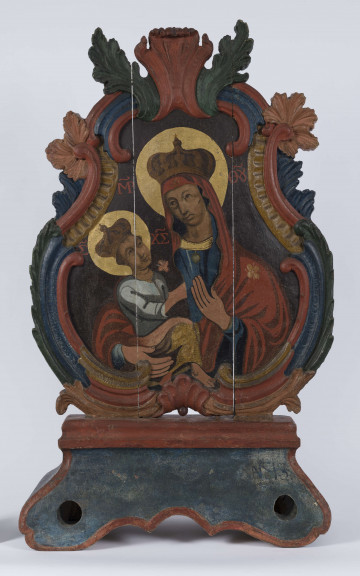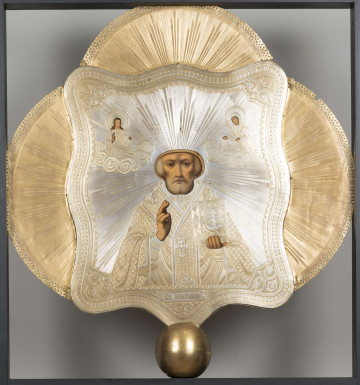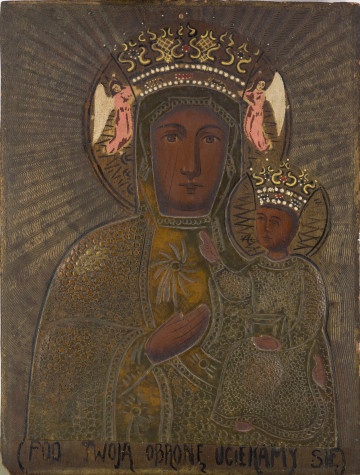
Our Lady of Chełm and Saint Nicholas
1801 — 1900
National Museum in Lublin
Part of the collection: Folk Art of the Lublin Region (17th–1st half of the 20th c.)
People have always travelled to places considered sacred. The faithful made pilgrimages to shrines in the hope of receiving God's graces, which were manifested particularly intensely there through a sign, a relic or an image, surrounded by solemn veneration. From there they tried to bring a likeness of the "miraculous image" home to protect their household and family. Hence, indulgence feast centres and artisan workshops were established at monasteries, including Częstochowa and Kalwaria Zebrzydowska. Devotional paintings from these centres were distributed all over the country by pilgrims or by the very painters, itinerant traders.
The oldest, from the 17th century, were the workshops of Częstochowa. The paintings of those artists usually had the form of rectangles composed vertically in one plane. They were distinguished from others by a strong wide contour, cutting off the figures from the background. The face and hands were worked out more carefully, robes and decorations were painted flat, without chiaroscuro, but more ornamented. The rose motif with large petals was characteristic, but there were also decorations with small flowers.
The workshops offered pilgrims a variety of themes. The most popular among the Marian images were: Our Lady of Feeding, Our Lady of Czestochowa, Our Lady of Koden, Our Lady of Gidel. The history of the shrine at the later Dominican monastery in Gidlach near Częstochowa dates to 1516 and is connected to the story of the statue of Mary with the Child. According to the legend, the statue was ploughed in the field belonging to the Gidzielski family property by a peasant Jan Czeczek, and then hidden in the cottage. This fact contributed to the loss of sight by members of his family, which they regained only after washing their eyes with water used for cleaning the sculpture and giving it to the parish church.
The painting depicts the moment when, while ploughing, the oxen stop and even fall to their knees in front of the statue shining in the ground, which the farmer considered a treasure. The iconography of the image itself is elaborate and divided into two plans. In the lower - earthly part, against the background of the landscape with the silhouettes of monastery buildings, the scene of ploughing up the statue is shown, while in the upper - heavenly part, the patrons of the Dominican Order, St Dominic and St Jacek, adore the miraculous statue often placed in a floral or radiant wreath.
Author / creator
Dimensions
cały obiekt: height: 50 cm, width: 61 cm
Object type
picture
Technique
painting technique
Material
paper, tempera
Creation time / dating
Creation / finding place
Owner
The National Museum in Lublin
Identification number
Location / status

1801 — 1900
National Museum in Lublin

1890 — 1910
National Museum in Lublin

1890 — 1910
National Museum in Lublin
DISCOVER this TOPIC
Museum of King Jan III's Palace at Wilanów
DISCOVER this PATH
Educational path